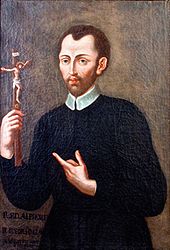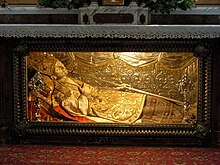Alfonso Maria de Liguori
Alfonso Maria de 'Liguori , Latinized Alphons (us) Maria de Ligorio (born September 27, 1696 in Marianella near Naples ; † August 1, 1787 in Pagani near Salerno ; German Alfons von Liguori ) was an Italian lawyer , moral theologian , bishop and founder of an order ( Redemptorist ), who was canonized in 1871 and made a Doctor of the Church .
Life
As the first-born child of noble parents , Liguori enjoyed a strict, demanding school education from private teachers. As a teenager he was able to paint, played the harpsichord and published a volume of poetry. At the age of 16, he received his doctorate in both rights in 1713 . At 19 he started his first trial as a lawyer. According to his own account, in 1723 he lost a sensational trial between two dukes through an intrigue on the part of the opposing party and was showered with ridicule.
After this defeat, he began to think about his life. On August 28, 1723, he decided to radically change this. He went to a St. Mary's Church to take off his sword as a sign of his nobility and began studying theology . He was ordained a priest three years later as a member of a world priestly association. As a result, his care was directed to the materially needy fellow citizens in Naples. He held popular missions against spiritual hardship , which would later become a defining characteristic of his order, and trained lay apostles in the work of the chapels .
An illness forced him to retreat to the small village of Scala near Amalfi . There he met the rural population, who he believed needed priestly pastoral care even more than the city dwellers. Therefore, he decided to work in these areas from now on. In order to be able to offer even more help, he founded the Order of Redemptorists together with Celeste Crostarosa in 1731 and a year later the corresponding male counterpart: the "Congregation of the Most Holy Redeemer", the Redemptorists , whose main task was to be the popular mission .
Jansenism, with its rigorism and pessimism , formed the opposite pole to its own program of preaching . Liguori contrasted this in his sermons with divine mercy, based on the Bible, the tradition of the Church and the example of the saints. The motto of his order was: Redemption is abundant with him ( Copiosa apud eum redemptio , Ps 130.7 VUL ). At Maria , God's mercy show in a special way.
In 1762 he was surprisingly called as bishop to Sant'Agata dei Goti near Naples, which he accepted only after long hesitation. Soon, however, he was absorbed in this position in a poor, neglected diocese and was venerated by the people as the “father of the poor”.
He headed the diocese until 1775. In the last few years he suffered from gout , so he used a wheelchair, he was half deaf and blind, but still full of creativity and affection for people. Liguori died in the Pagani monastery he had founded near Naples, to which he had retired.
Liguori also made a name for himself as a composer of sacred songs . The most famous Italian Christmas carol Tu scendi dalle stelle comes from him.
theology
Liguori mainly influenced the Catholic moral theology, which continues to this day. Spiritual aspects play a large role in his thinking, which is why he was opposed to moral rigorism. A central topic for him is the practice of confession . In the case of ear confession , the priest has the task of persuading the confessor to communicate very specific facts. Critics have (and still is) objected that children should not be exposed to this situation; In addition, such a method of confession causes a disproportionate concentration on the sexual field ("sinful thoughts and deeds"). Liguori himself saw human sexuality primarily as a danger zone that should be contained if possible.
Liguori also played a significant role in the theological discussion about the " infallibility of the Pope ". With his extensive work The Truth of Christianity and the Infallibility of the Church and its Head of the Pope defended against the deniers of God, the enemies of revealed Christianity and the opponents of the Catholic Church (in German: Regensburg 1845; original title: Verità della fede. Fatta evidente per i contrassegni della sua credibilità , 1767) he prepared the dogmatic statements established in 1870 at the First Vatican Council .
Adoration and criticism
Worship in the Catholic Church
Alfons de 'Liguori was canonized in 1839 and, thanks to this already extraordinary ecclesiastical honor, was once again raised to a very special rank in 1871 when he was declared a Doctor of the Church (“Doctor ecclesiae”). In 1950 the Pope also made "St. Alphonsus" patron saint of confessors and moral theologians.
In addition to Redemptorists, there are other communities that are oriented towards the pastoral goals and spirituality of Liguori. These include the Missionary Sisters of the Most Holy Redeemer and the lay community of Alfons Liguori Friends. Liguori's day of remembrance of saints is August 1st .
The Alfons von Liguori churches are dedicated to him. The Catholic School St. Alfons in Berlin is named after him.
The Liguori biographer Thédule Rey-Mermet (“Alfons von Liguori”, Freiburg 1987) calls him a “giant in the history of spirituality” and “saint of the Enlightenment”.
criticism
On the Protestant side, and especially by anti-Catholic church critics, Liguori was attacked again and again and his objectives as well as the methodology were problematized. The particular sharpness that is often found here is explained by the fact that he was considered a representative of Catholic bondage and hypocrisy of piety.
Robert Grassmanns brochure excerpts from the by the Popes Pius IX. and Leo XIII. ex Cathedra as the norm for the Roman Catholic Church sanctioned moral theology of Saint Dr. Alphonsus Maria de 'Liguori and the terrible danger of this moral theology for morality (Stettin 1894) was widespread around 1900 and afterwards in hundreds of thousands of copies. But even beyond such sharpness, liberal Protestants and Old Catholics saw in him the typical representative of the Catholic “black man”, for which his authorship of the dogma of papal infallibility and his moral theological positions qualified him.
The canonization of Liguori fell at a time of intensifying conflicts between the Catholic Church on the one hand, Protestant churches and Protestant Prussia on the other ( Cologne church dispute ). According to Protestant critics, the canonization was a strategic maneuver in the context of the church-political offensive program of Pope Gregory XVI. which also included the demonstrative promotion of the belief in the Immaculate Conception of Mary , which outside the Catholic Church was rather mockingly commented on (raised to dogma in 1854).
In Max Weber's writings on the sociology of religion , Liguori is a prototype of the fear of sin and the "sexual neurasthenic".
In 1848, Johann Strauss composed an ironic, quasi-revolutionary Liguorian polka of sighs for his order .
Works
- Elements of a spirituality of love. Recktenwald, Cologne 2000.
- The great grace of prayer. Hausler, Landshut 1998, ISBN 3-00-003671-7 (according to his own statement, his most important work).
- The glories of Mary. Priestly Society of St. Pius, Priory St. Athanasius, Stuttgart 1991, ISBN 978-3-932691-03-4 .
- Learn to love Jesus. Brendow, Moers 1997, ISBN 3-87067-382-6 .
- Order of life of a Christian. Recktenwald, Cologne 1997.
- Practical instruction for confessors or homo apostolicus. Pustet, Regensburg 1854 ff. (Reproduction of the 1759 edition) (one of the most important works of moral theology of its time)
- Theologia moralis. ADEVA, Graz 1953 (reproduction of the 1743 edition)
literature
- F. Bourdeau (Ed.): Alphonse de Liguori: pasteur et docteur. Beauchesne, Paris 1987, ISBN 2-7010-1144-2 .
- G. Cacciatore: Alfonso Maria de Liguori, santo. In: Alberto M. Ghisalberti (Ed.): Dizionario Biografico degli Italiani (DBI). Volume 2: Albicante – Ammannati. Istituto della Enciclopedia Italiana, Rome 1960, pp. 342-350.
- Harold Castle: St. Alphonsus Liguori . In: Catholic Encyclopedia , Volume 1, Robert Appleton Company, New York 1907.
- Josef Heinzmann: unrest of love. Alfons Maria of Liguori (1696–1787). Freiburg (CH) 1983, ISBN 3-85764-159-2 .
- Martin Leitgöb: Alfons of Liguori. Teacher of prayer and mercy. Tyrolia, Innsbruck 2010, ISBN 978-3-7022-3097-5 .
- Thédule Rey-Mermet: Alfons of Liguori. Freiburg im Breisgau 1987.
- Otto Weiss : Alfonso Maria de Liguori. Theology for the sake of pastoral care. In: Peter Walter, Martin H. Jung (ed.): Theologians of the 17th and 18th centuries. Confessional age, pietism, enlightenment. Knowledge Buchgesellschaft, Darmstadt 2003, ISBN 3-534-15763-X , pp. 166-180.
- Otto Weiß: German or Roman Morality? - or: The dispute over Alfonso Liguori. A contribution to the discussion between Romanism and Germanism in the 19th century (= sources and studies on the recent history of theology 5). Pustet, Regensburg 2001, ISBN 3-7917-1744-8 .
- sv : Alphonsus Maria de Liguori, p . In: Johann E. Stadler , Franz Joseph Heim, Johann N. Ginal (Eds.): Complete Lexicon of Saints ... , Volume 1 (A – D), B. Schmid'sche Verlagsbuchhandlung, Augsburg 1858, p. 148 -149 .
Web links
- Literature by and about Alfonso Maria de Liguori in the catalog of the German National Library
- Works by and about Alfonso Maria de Liguori in the German Digital Library
- Entry on Alfonso Maria de Liguori on catholic-hierarchy.org
Individual evidence
- ↑ The more recent church-historical assessment of his work (beyond the veneration of saints and personality cult) is given by Otto Weiß: Alfonso Maria de Liguori. Theology for the sake of pastoral care, in: Theologians of the 17th and 18th centuries. Confessional age, pietism, enlightenment. Edited by Peter Walter and Martin H. Jung, Darmstadt 2003, pp. 166–180.
- ↑ See Carl Mirbt : History of the Catholic Church from the middle of the 18th century to the Vatican Council (= Göschen Collection . Volume 700). Berlin and Leipzig 1913, pp. 76-77.
- ↑ See Joachim Radkau: Max Weber. The passion of thinking. Hanser-Verlag, Munich 2005, p. 299. Radkau refers to the writings Protestant Ethics , Economy and Society and Ancient Judaism , in each of which Liguori is cited in the aforementioned sense (p. 298). Radkau also says: "Even today, instructions from this saint circulate among traditional Catholics on how to put on and take off trousers without irritating the genitals" (p. 299).
| personal data | |
|---|---|
| SURNAME | Liguori, Alfonso Maria de |
| ALTERNATIVE NAMES | Liguori, Alfonso Maria de ' |
| BRIEF DESCRIPTION | Italian lawyer, bishop and founder of an order, who was canonized and made a Doctor of the Church |
| DATE OF BIRTH | September 27, 1696 |
| PLACE OF BIRTH | Marianella near Naples |
| DATE OF DEATH | August 1, 1787 |
| Place of death | Pagani near Naples |

